page 1
http://threesology.org
| What is time pg 1 | What is time pg 2 | What is time pg 3 | What is time pg 4 | What is time pg 5 | What is time pg 6 | What is time pg 7 | Time Travel Considerations |
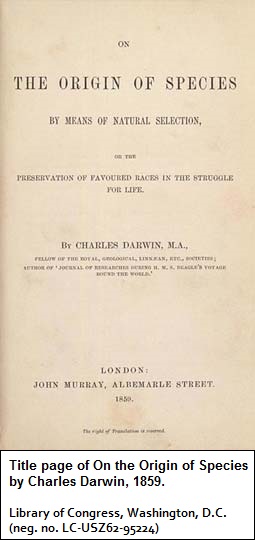
The heading of this page is inspired by a question posed by Tiffany J. on a Face Book comment in the middle of November, 2017... that I was unable to address at any length due to a planned departure from my wifi access point (a public library). Let me now pursue it with the present interlude that is much too lengthy for a Face Book caption with the caveat that because there is so much material that can be used as a reference to time, the same or similar information may be used two or more times in different instances because it affords us with alternative perceptions of the same material. In short, there is lots of phenomena that can be associated with time and many subject areas to choose from in beginning the trek. While you may personally prefer to eschew one or another topic, others may prefer them and accept that they represent any number of generalized or specialized considerations which could be brought to the discussion. While some prefer to not go into the water and may or may not linger near the shoreline, others may dip a toe or their hand to test its temperature... while still others either dive or jump in to see what sort of splash they can make. Which of the three are you? Do you fear you might encounter something ominous lurking beneath the surface, or some yet to be discovered treasure? Or perhaps you prefer to venture forward only in as much as you can stand or sit on the surface of a raft, boat or ship from a vantage point you label a pier, another labels a wharf and still another labels a dock? In any respect, where's your sense of adventure?
The concept of time remains largely unexplored by the general public except for perhaps in the context of a time travel movie, and is more often taken for granted as can be derived from the material found in all subject areas such as chemistry, physics, mathematics, geology, astronomy, anatomy, medicine, music, poetry, etc., at different periods of history. For example, the topic of Evolution took on a widespread social currency after Darwin's "The Origin of Species" (by means of Natural Selection)... though the "means by artificial selection" has become a reality in the present age with respect to an interest in manipulating genetic materials such as for staving off the occurrence of some predisposition to a particular disease or deformity. Apparently, before the publication of this work, the idea of evolution was not even thought of by many people... or they took associated ideas for granted based on their understanding of the Bible. Thoughts concerning very distant events which did not include the presence of humanity may have rarely... if at all, come to the considerations of the general public as a topic of wide-spread consideration. For example, those who chanced upon a dinosaur fossil, their thoughts were not "socially in tune" with the framework necessary for contemplating further considerations and may have simply ignored the fossil or off-handedly examined it with a superficial sense of curiosity before dropping it back on the ground to be stepped on by others. Oh so many are quite content to view time as being little more than a tool to organize behavior in accordance with, so as to carry about the practicality of day-to-day efforts according to the time period one exists in and determines their living requirements. (For example, the living requirements of someone living in a Neanderthal community were different from those of someone living in ancient Egypt or present day Italy.)
If we use a change in geologic or biological occurrences as an indication of representative time in a given context, we should also note the differences the length of time can take with respect to the duration of measurement in relation to other impressions, such as how the length of a day is altered by the slowing of the Earth's rotation. In other words, events along a timeline should be referenced according to a measurement of time if that measurement is being altered by a change in an environmental or planetary presence. In other words, the length of a day gets shorter the faster the Earth is spinning in relation to the Sun and Moon, whose rhythms may well be impressed upon by different life forms like the rings of tree which record changing environmental conditions of time. For those life forms which conform to the periodicity of lunar events, they may well express their "timescape" in respective growth rings or evolutionary changes over extended periods of time which may contribute to biological or structural forms of time-keeping not easily identifiable because the consistency of the time-keeping record changes according to prevailing availability of resources that enable the record to be kept. In this instance it would be like a person used to using a piece of charcoal having to use a pencil, then a pen, then a computer, or something else, but the succession of different materials and mediums to make a record may not be as clear-cut as this example. Timely changes may not always take place on the exoskeleton or hide of a creature, they may occur internally instead. In any respect of thinking about different alternatives of scenarios which may take place from one life for to the next living under different conditions, the passage of time with the respect to the length of a day as measured by the rate of the Earth's rotation in relation to the Sun and Moon, has changed over time. Interestingly, when we look at the arrival of different life forms and the rate of a day length, we should keep in mind that life forms may be "rotation rate specific", in that, such as humans for example, they may be able to survive in a narrow spectrum of rotation. A slowing Earth may one day prove to be too hazardous for humans whose biology was born when the rate of rotation was different, and can not readily adapt to a slower rotation rate.
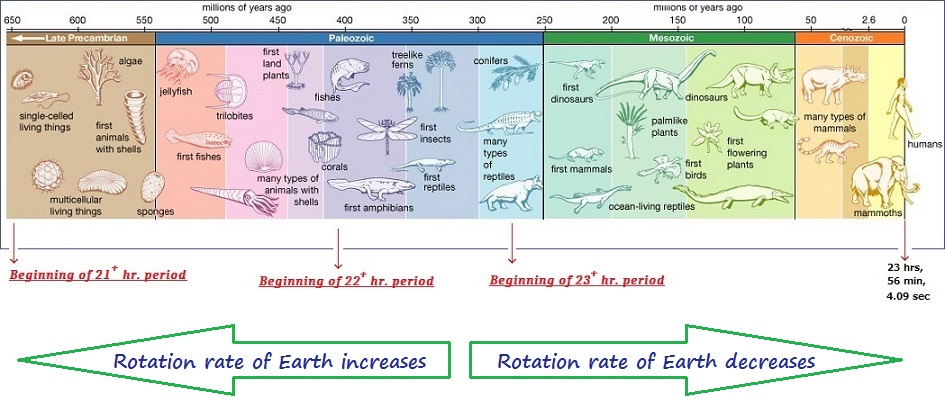
With respect to human-linked fossils used as an analogy for representing different species of Time, let us not forget to include the reference of a hoax called the "piltdown man" used to illustrate a link between apes and early humans and was accepted by various scientists in the early twentieth century. This is included as an example for those who may be ready to accept any and all analogies concerning time, though expected or required evidence may be sparse or even non-existing. Unlike a fossil record of early hominids, what sort of "fossil" record could be devised for time? From which of the many subjects would you extract examples to represent different ideas related to time in an effort to expand considerations thereof? Would you restrict your examples to human events? And and all biological events? Geological events? Cosmological considerations? What abstractions might you devise which will enable human consciousness to expand its horizons in thinking about the topic labeled time?
However, it should be understood that discussions about a topic which may tread the boundaries of infrequent intellectual walks by multiple people, may well be viewed as nonsense, abstract or insanity by those who prefer to stroll along trails where views are better established as conventions of consideration by others... particularly those in one's social purview. They may not like to creatively explore alternative considerations because they become too easily lost if there are no established moorings that multiple others are using as well. Words and ideas, such as in the writing of poetry is not a widely accepted genre for letting one's mind wander into uncharted waters of time and space. When I attempted to do so in a creative writing class many decades ago, the instructor and other students were alarmed by some of the associations I made because the ideas did not agree with the accepted notion of what was considered to be creative... at least from their collective perspective. It was very difficult trying to convey alternative perceptions using multiple materials from different subjects, because most of those in the class had very small knowledge bases. I couldn't combine elements from different subjects because they had little or no familiarity... and therefore preferred to dismiss my portrayals as irrelevant or damaging to the "mood" of the class which was bogged down in intellectual and emotional mediocrity. I quit the class and never returned to another so-called "creative writing" course in which the presumed allowance for creativity actually stifled imaginative expressions in order to make everyone "stay on the same page" to coincide with the limitations of imagination of those who dominated discussions in the class. Whereas imaginative thinking is said to be permitted, the medium of writing used as a vehicle to transport impressions, allusions, digressions, alternative compilations and deletions into some similitude of expression does not readily permit someone the ability to socially display considerations that trespass into areas where most others prefer to use music, math or art... because these mediums more readily allow for creative explorations that may at times venture into states of disassociation and accepted... or accepted congruency.
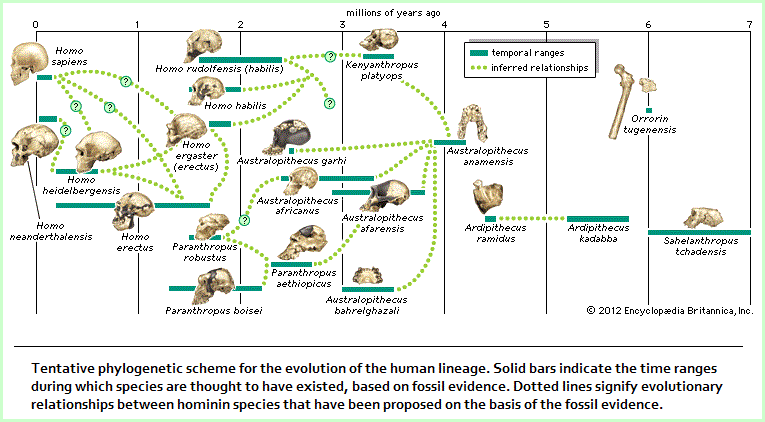
So let us ask "What is time?" as if it were a fossil remnant of one or more creatures that can be associated with a variety of tracks embedded in the mediums of different subjects, though many tracks and fossil remanents may have become obscured or even lost through erosion, composting, etc... Then again, in our efforts to examine this phenomena which gives several indications of being a "living fossil", is it best described by the constraints of human cognition? Is humanity psychologically prepared to delve into the recesses of time, or can be at best only fiddle with it as a child with a stick probing an ant colony? And along with the question of what Time is, we might as well ask "What Is Number?", since how we think about time frequently incorporates some reliance on numerosity, or a non-numerical reference on the surface ...but with a particularized numerosity that may be little more than a generalization with self-definable boundaries such as "some", "many", "a few", "a bunch", etc...
When speaking of time, do we prefer a specific label to assist in our definition, such as solar time, lunar time, Universal time, standard time, space-time, music time, cooking time, daylight savings time, scheduled time, or geologic time? Like a clock being partitioned into segments such as seconds, minutes and hours, do the various references to different interpretations and uses imply there is... or there is not an overall face to time? If we can not simply use any single day to day human value of time related to planetary events such as seasons, what criteria are we to use to acquire a greater clarity? Did time begin as a single entity (singularity) and then branched off into different composite varieties like the evolution of cosmic phenomena? Did time arrive on the scene of existence at the moment of the Big Bang... or was this a different type of time than that which preceded it?
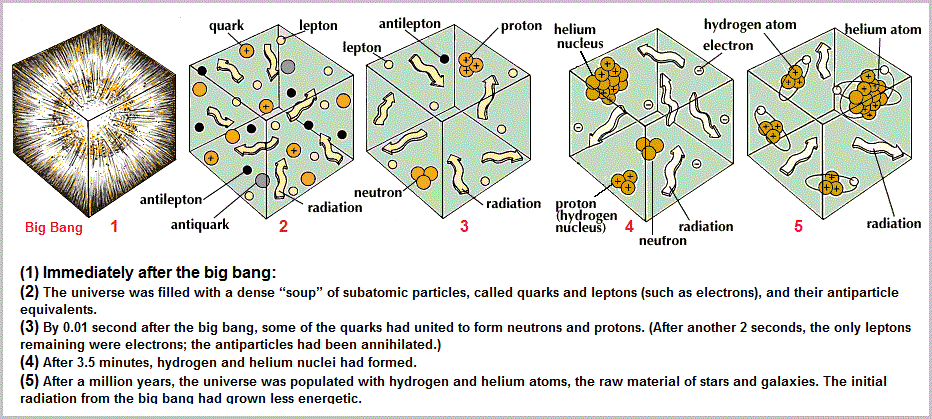 | |
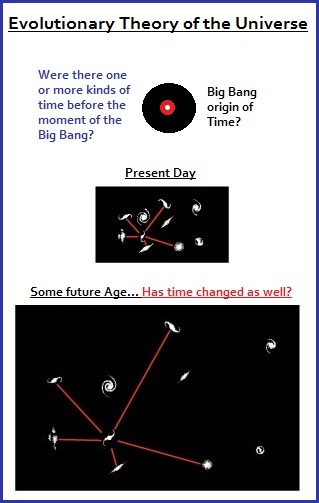 |
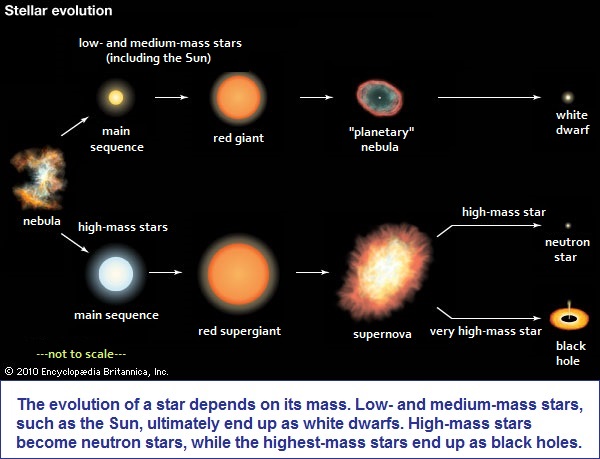 |
Is time an object of sorts and it is possible to actually save time in a bottle, cigar box, hope chest, knick knack shelf, pouch, purse, billfold, or large coffee can as one might some item that references a memory? Can it be heard, smelled, touched, tasted or alternatively sensed beyond our psychological impositions? Does time have color or is it black and white? Was time created or did it grow... and is still growing... old and/or younger? Is time a thing, place or became into being solely because of a "person" such as humanity? And what if there is no consciousness to conceive of time, does time not exist... or can it exist without the need of knowing that it does?

As an added feature of examples to the "time in a bottle" reference, time-related memories and ideas can also be invoked by including the references "ship in a bottle" and "message in a bottle", both of which are related to the sea or ocean and may describe a metaphorical link to an underlying memory originating in water, like salmon returning upstream to their place of birth and the open sea or ocean giving reference to the time spent in the watery womb of infancy. Because water plays such an important part to life and non-life processes, it's no wonder there are many nautical terms which crop up in language and how many references involve some presence of water in one form or another.
 |

|
Can we find a better attributive definition of time by making analogies to animal behavior such as migration which originates under one influence or another? Does time have a birthplace and does it make timely treks back to its origin(s)? Does time in fact repeat itself with respect to some unrecognized migration based on some inherent instinct that involves some breeding or feeding ritual? Indeed, let us ask if time has offspring and practices social patterns of behavior. Is time a life-form species? And instead of the "Father Time" anthropomorphism we should be saying something like "Rhinoceros, Raccoon, or Reptilian Time"? Though some readers are familiar with the "Time is an Arrow" concept, we might want to ask where the image for the first arrow came onto the scene of human perception, and how did the point become interpreted to represent the direction of flow? Are there many species of time and do they exhibit characteristics found in animal, plant, viral or bacterial behavior?
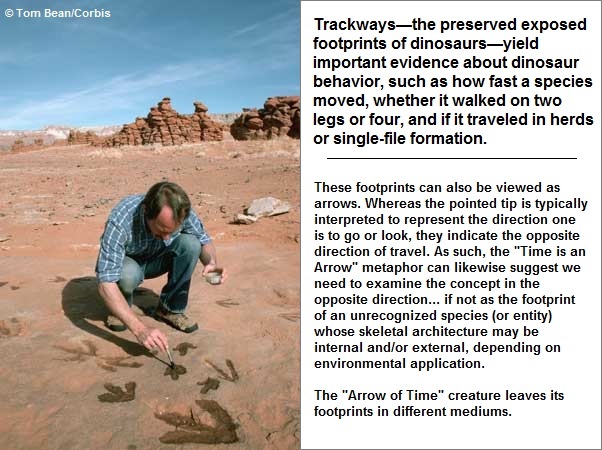
A hunter can not find its prey if they go in the adopted direction of the arrow.
(An arrow points away from the direction an animal is going: →→→)
It should not come as a surprise that Deinonychus was a social animal, because many animals today are gregarious and form groups. Fossil evidence documents similar herding behaviour in a variety of dinosaurs. The mass assemblage in Bernissart, Belgium, for example, held at least three groups of Iguanodon. Group association and activity is also indicated by the dozens of Coelophysis skeletons of all ages recovered in New Mexico, U.S. The many specimens of Allosaurus at the Cleveland-Lloyd Quarry in Utah, U.S., may denote a herd of animals attracted to the site for the common purpose of scavenging. In the last two decades, several assemblages of ceratopsians and duckbills containing thousands of individuals have been found. Even Tyrannosaurus rex is now known from sites where a group has been preserved together. These rare occurrences of multiple skeletal remains have repeatedly been reinforced by dinosaur footprints as evidence of herding. Trackways were first noted by Roland T. Bird in the early 1940s along the Paluxy riverbed in central Texas, U.S., where numerous washbasin-size depressions proved to be a series of giant sauropod footsteps preserved in limestone of the Early Cretaceous Period (146 million to 100 million years ago). Because the tracks are nearly parallel and all progress in the same direction, Bird concluded that “all were headed toward a common objective” and suggested that the sauropod trackmakers "passed in a single herd." Large trackway sites also exist in the eastern and western United States, Canada, Australia, England, Argentina, South Africa, and China, among other places. These sites, dating from the Late Triassic Period (229 million to 200 million years ago) to the latest Cretaceous (65.5 million years ago), document herding as common behaviour among a variety of dinosaur types. Some dinosaur trackways record hundreds, perhaps even thousands, of animals, possibly indicating mass migrations. The existence of so many trackways suggests the presence of great populations of sauropods, prosauropods, ornithopods, and probably most other kinds of dinosaurs. The majority must have been herbivores, and many of them were huge, weighing several tons or more. The impact of such large herds on the plant life of the time must have been great, suggesting constant migration in search of food. Nesting sites discovered in the late 20th century also establish herding among dinosaurs. Nests and eggs numbering from dozens to thousands are preserved at sites that were possibly used for thousands of years by the same evolving populations of dinosaurs. Source: "Dinosaur." Encyclopædia Britannica Ultimate Reference Suite, 2013. |
Let us take a look at further comments about migration to see whether we are imaginatively willing to apply them to time in order to create a framework from which a scaffolding can emerge that will be used in the construction of a larger appreciation of time, and in the added sense that migrations also represent graphs, though the intersecting lines may not be easily recognizable by some viewers:
Migration, in ethology, (refers to) the regular, usually seasonal, movement of all or part of an animal population to and from a given area. Familiar migrants include many birds; hoofed animals, especially in East Africa and in the Arctic tundra; bats; whales and porpoises; seals; and fishes, such as salmon. 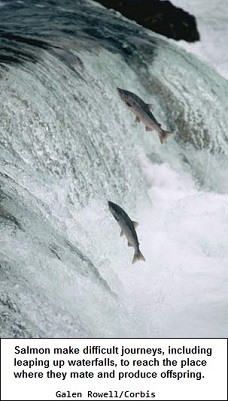
Migration can be contrasted with emigration, which involves a change in location not necessarily followed by a return journey; invasion or interruption, both of which involve the appearance and subsequent disappearance of great numbers of animals at irregular times and locations; and range expansion, which tends to enlarge the distribution of a species, particularly its breeding area. The migration cycle is often annual and thus closely linked with the cyclic pattern of the seasons. The migration of most birds and mammals and many of the fishes are on a yearly cycle. In many cases (e.g., salmon and eels) animals with a relatively long life-span return to the place of birth in order to reproduce and eventually die. In other cases, as in certain invertebrates, where the animal has a relatively brief life-span and reproduces rapidly, migrations may not occur in every generation. The daily movements of certain fishes and invertebrates have also been called migrations because of their regular occurrence. This type of movement, however, is not to be confused with migration in the strict sense. 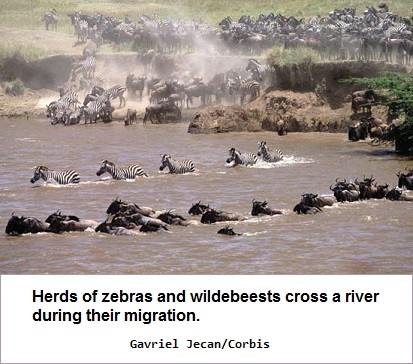
Most migrations involve horizontal travel. The distance traversed may be a few miles or several thousands of miles. Some migrations take a vertical direction and involve no appreciable horizontal movement. Certain aquatic animals, for example, move from deep water to the surface according to the season. Certain birds, mammals, and insects migrate altitudinally in mountainous areas, going from the upper zones, where they breed, to the foothills or plains during seasons when the weather is severe and unfavourable. Such vertical travels involve essentially the same type of environmental change as horizontal, or latitudinal, migrations over long distances. Source: "Migration." Encyclopædia Britannica Ultimate Reference Suite, 2013. |
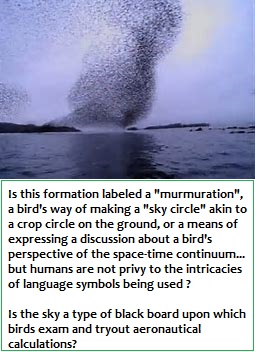
Note: Since I will mention references to various linear, circular and triangular forms later on, it is of need to point out that many migrations take on a linear pattern, though the flights of birds in the day and night time appear to take any one of these configurations such as the V-shape, 7,L,J or Diagonal line formations. Shorter distance formations can exhibit circular or "bunched up" gatherings while I have seen long undulating columns of birds called murmurations, such as those exhibited by starlings. The word "murmur" brings to mind the word "babbling" frequently assigned to the behavior of infants, along with the notion of "reduplication" in that the same sound may be repeated, like a dog chasing its tail or birds following a routine flight plan whose strategy seems otherwise directed than for finding food, shelter or mate(?)
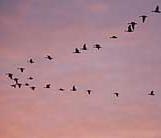 V-shaped formation |
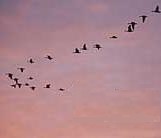 L, 7, or J-shaped flight formation |
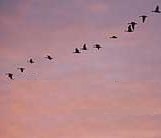 Diagonal-shaped formation |
Is murmuration amongst birds a type of language that humans incorrectly decipher because they are distracted by the images... like someone who can not see the forest because the trees are getting in the way of looking for something other than trees to define a forest? Is this the problem with humans trying to uncover a Theory of Everything in physics or grasping what is time? Is there no one to recognize the following "Bird Circle Formations" within the schematic of Crop Circle Formations and their relation to time?
(Crop circular-like imagery in the sky)
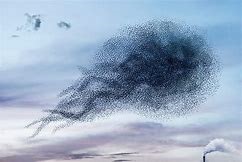 |
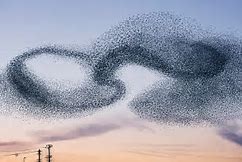 |
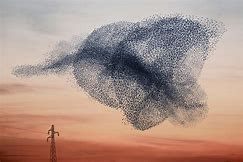 |
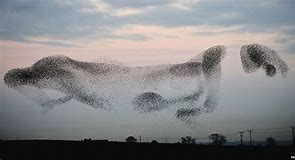 |
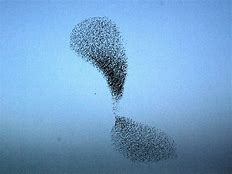 |
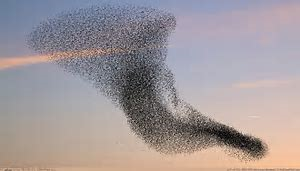 |
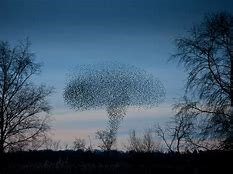 |
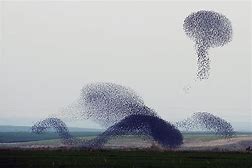 |
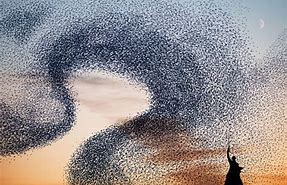 |
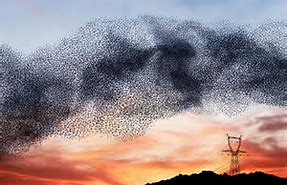 |
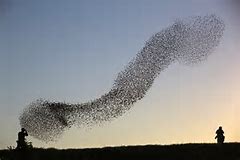 |
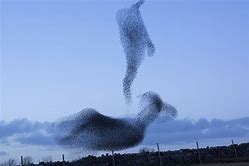 |
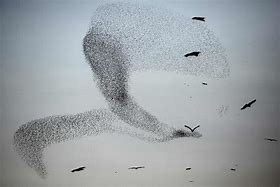 |
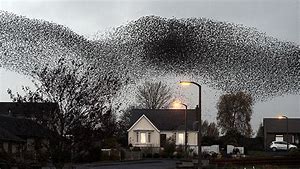 |
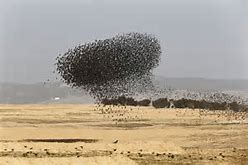 |
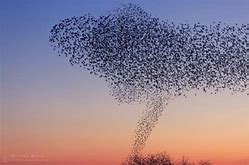 |
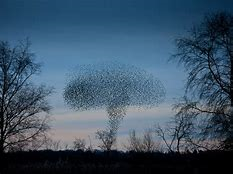 |
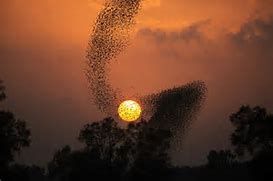 |
In discussions of time, we encounter those who think it goes in one direction (from beginning to end), and those who consider it be by cyclical such as in notions of rebirth. While there may be variations on these two themes, there does not appear to be a stark representation of any other geometric form, such as a triangle... though in fact time may be anything but singularly straight or circular. This point is of interest to make note of since there exists an environment event which has occurred for billions of years, and no doubt been impressed upon biological processes to create lasting impressions which come to be expressed by different organisms within their respective physiological capacities. The event to which I speak of is the triangular path of the Sun and the moon. While the following images are of the moon, with a reversed image used as a means to outline the whole passage, this same triangular pattern occurs with the Sun.
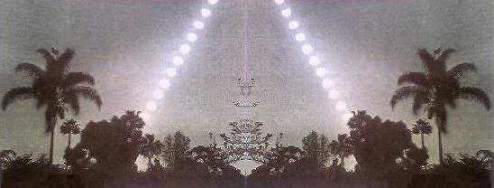 |
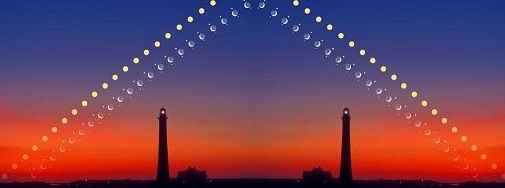 |
Page initially created: Thursday, 16-Nov-2017... 05:10 AM
Initial Posting: Sunday, 15th-April-2018... 7:28 AM
Updated Posting: Tuesday, 29th-May-2018... 11:49 AM
Herb O. Buckland
herbobuckland@hotmail.com
